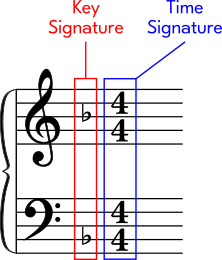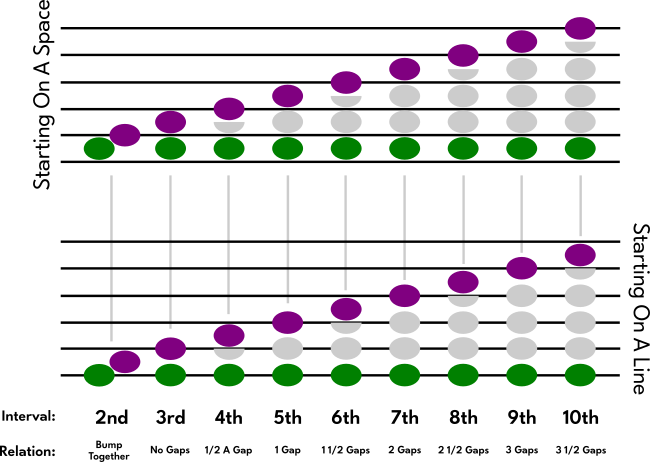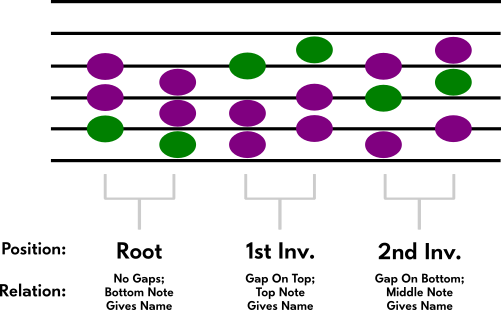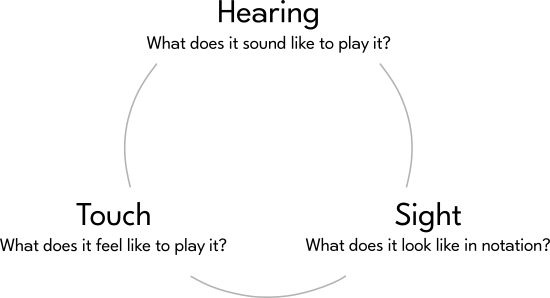Back • Return Home
Tips For Sight-Reading
First, we need to generally understand what a piece of sheet music is telling us (i.e.: how the location of a Note on the Staff vertically tells us its Pitch, how the sequence of Notes horizontally across the Staff tells us the order in which they are to be played, how the shape of the Note itself tells us how long to hold it, etc.). A familarity with how each of the Notes on the Staff corresponds to the Notes on our instrument is very important. We cannot be struggling to remember what Pitch corresponds to which space or line, nor where/how to find that Note on our instrument. Condition this into a habit in whatever way is most comfortable for you.
Then, we should be able to...
• Recognize and play the basic Scales associated with each Key Signature
• Count and feel the Rhythms specified by basic Time Signatures (e.g.: 4/4, 3/4, 2/4, 3/8, 6/8, 9/8)
These skills come up immediately as they are always right at the start of every piece of Sheet Music. For example:
Next, we should be able to quickly recognize what basic Intervals and Chords look like within a piece of sheet music. Let's start with the Intervals...
Whether starting on a line or space, each Interval is a certain sized gap between the two Notes that make it up:
Image adapted from one within the course A Year's Worth of Piano Lessons in One Weekend by Donna Cercone
Eventually, we will not try to decipher it Note-by-Note, but recognize the Contour of lines as a whole. For example:
Sheet music will not usually have huge leaps on the same Staff.
...Let's move on to Chords. Donna Cercone points out a very useful pattern that can help us to recognize basic Triads at a glance:
Notice that, whether starting on a space or a line, each Chord Position has a particular structure. To reiterate:
• Chords in Root Position do not have any gaps in between Notes. All Notes are on either lines or spaces. The bottom Note is the name of the Chord.
• Chords in 1st Inversion have a gap on the top. The top Note is the name of the Chord.
• Chords in 2nd Inversion have a gap on the bottom. The middle Note is the name of the Chord.
In the case of playing piano, our thumbs and pinkies are usually the ones that hit the top and bottom Notes of a Chord. We have to open our hand a particular amount in order to reach this Interval. If we already know the fingerings for the Triads in each Position, then we should automatically be forming the appropriate hand shape as soon as we see the Note that indicates the name of that Chord (the one in green in the above diagram). Target that Note, see the overall shape that tells you the Position of that Chord, and drop your hand into place. Do not try to read the Chord out Note-by-Note.
In the same way that we cannot read text out-loud if we are stumbling over the pronunciation of individual letters and words, we need to develop familiarity with these symbols and be able to form the corresponding shapes with our hands as soon as we see them. As it becomes more natural, we will take in information in gestalts, and be able to anticipate what is coming by looking ahead of what we are actually playing in the moment. Unless we have already memorized a musical piece, being comfortable with these foundational skills is the only way to fluidly sight-read it.
No matter what instrument we are playing, there are always three aspects that have to come together:





